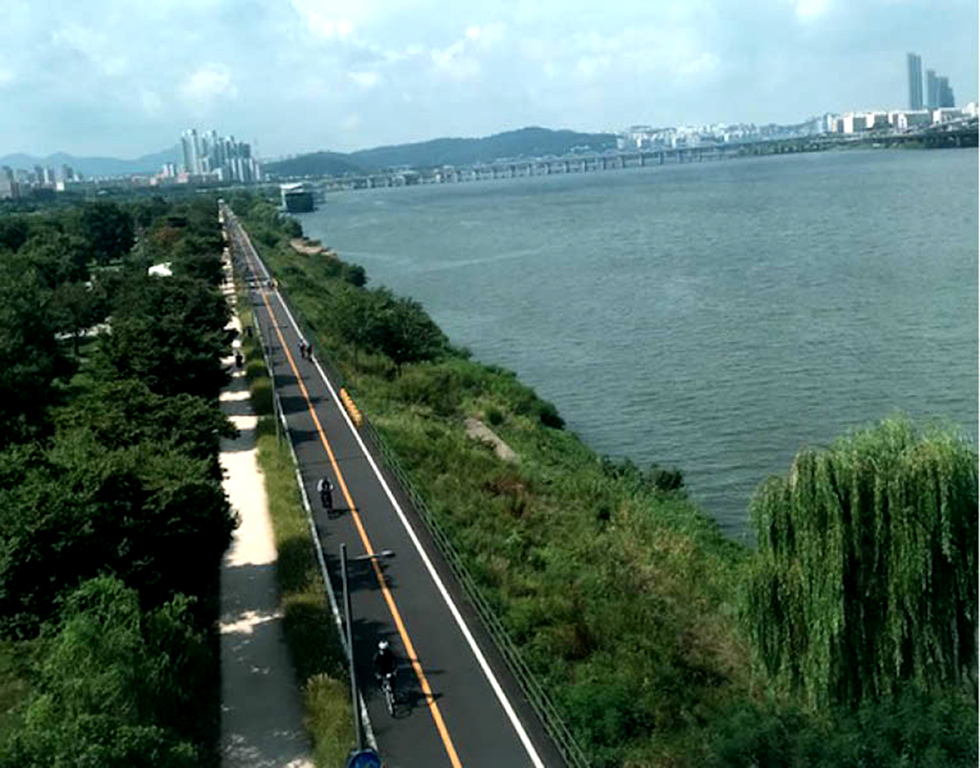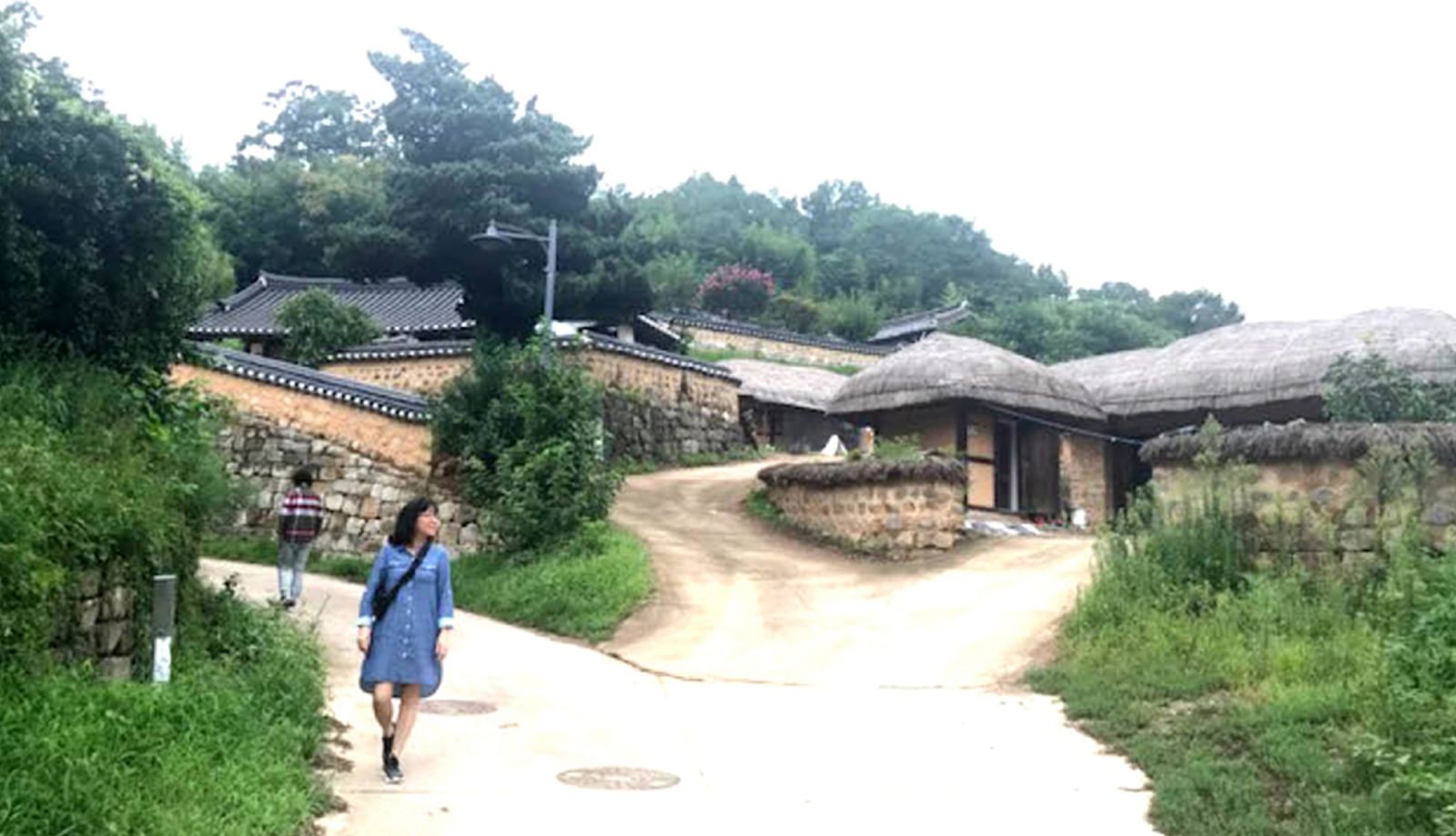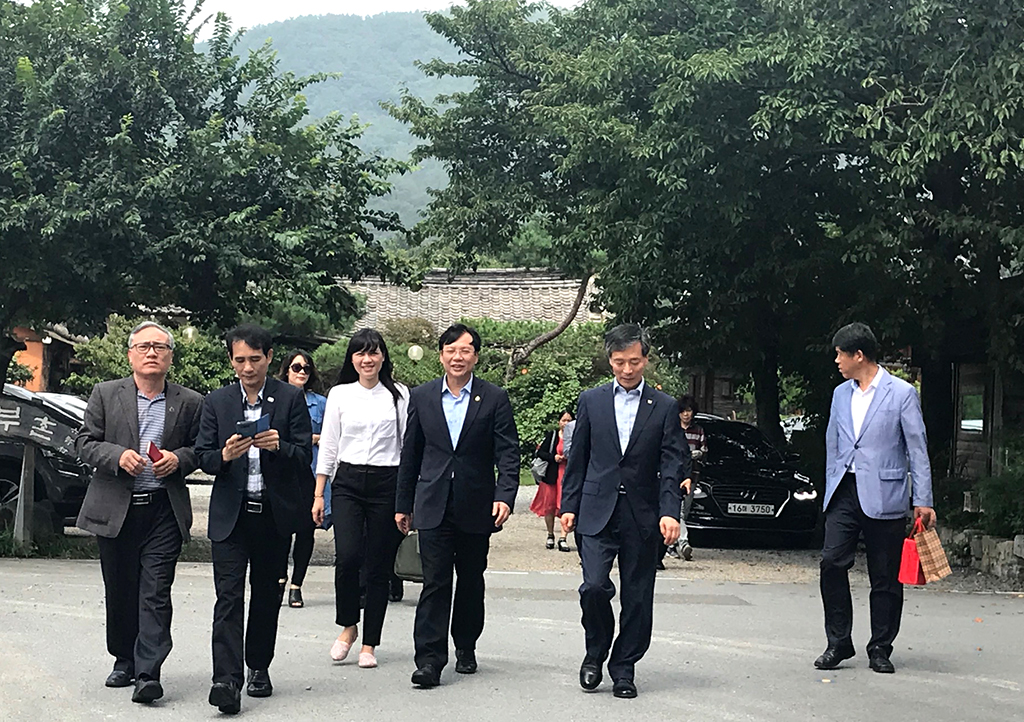
I did not know whether it was because of the open air or because of the green tiled roof of the Gyeongbokgung Palace that made the air a bit cold. But that crisp, cold air woke us travelers who had just got off the plane with little half-asleep and who were still rather unadjusted to a new land with a two-hour time difference.
There was not much greenery compared to Hue's Royal Citadel, so I thought of another great Joseon Dynasty, with the name of the palace that meant a blessing from nature. The height of Geunjeongjeon - the Imperial Throne Hall, the space between the artifacts, or perhaps the two-tiered roof system of both the main hall and the Gwanghwamun Gate and the colors of the palace that created a cold atmosphere. But perhaps it was because I was so accustomed to the warm, golden architecture of the Nguyen Dynasty where I live.
We did not see the mountains of Bugaksan and Namsan, maybe because there was not enough time, and as there was no mention of this. Perhaps the skyscrapers had hidden the view of the two mountains surrounding the palace. The presence of modern architecture right next to traditional architecture was not overwhelming but contained a clear message of development and preservation - something that I was sure that it was not easily acceptable in other heritage areas.
But Gyeongju was different. The greenery of the trees along the street, the low roofs hidden amidst the gardens, and the moderately high buildings showed the quiet silence of an ancient capital - the site of the Silla Dynasty and also the capital since 57 BC.
Honestly, I kept thinking of catching a calm breath during my hasty stay here. The small-sized city of about 280,000 people had integrated a homogeneous style and harmony in color and design, with ancient tile roofs on most of the buildings, from homes to the stores or the shopping center.
 Streets along the Hangang
Streets along the Hangang
Gyeongju was similar to my Hue in style, not because of the partnership and signing of cultural cooperation agreements between the two cities of the two countries which was implemented almost 11 years ago, but there was just something I cannot put into words, like a gentle flow that I met again when away from home. In a gentle and soft voice, the story that Ms. Park Soon Hee, the city hall volunteer guide who led our delegation’s two-day tour of Gyeongju, helped us visualize the formation and development of the city, as well as efforts in preserving traditional values.
I remembered reading somewhere about young people migrating to big cities to look for jobs and the concerns about the demographic decline with this trend. This was most evident in the folk village of Yangdong, where nowadays almost only the elderly lived and coordinated with the authorities in promoting tourism and introducing visitors to the historical, architectural and traditional cultural values.
I thought of the ancient Phuoc Tich village when I stood next to a straight hedge of some kind of shrub similar to the tea trees, but a bit firmer and full of thorns. It made me cry out when I leaned back on the seemingly harmless hedge. Another funny encounter was when my colleagues and I thought we had just come to a green hill right in the center of the city. It turned out that it was Daereungwon Tomb (also known in Vietnamese as Thien Ma Tombs - the most represented symbol on the relics found when excavating ancient tombs).
Ms. Park Soon Hee said, according to legend, those who were more well-off were buried on the ground surface with the hope of coming back in the next life as human. In the Daereungwon Tomb, the stones were arranged in a certain sequence around the coffin, enclosed with artifacts. The top of the coffin was covered with dirt and planted with grass. This was an archaeological site that we were able to witness. The tomb architecture was completely different from the tomb system of Hue.
 Yangdong folk village
Yangdong folk village
The most pleasant experience was when I saw lotus flowers in Gyeongju, in a small pond behind a restaurant by the small fields on the road leading to Yangdong Folk Village where we stopped for lunch, which the Vice mayor himself invited us. Next to the old lotus flowers with brown seeds were a few late pink blossoms. They looked equally delightful as the colors of the multiflora roses – or tuong vi or tu vi in Hue's dialect. The multiflora roses were often seen planted between the gingko trees along the cities that we travelled by.
If I speak of serenity, I certainly think of Mungyeong, a city in Gyeongsangbuk Province, which was located mainly in the Sobaek Mountains. It was also home to the traditional pottery village and the famous ceramics festival Mungyeong Chasabal held annually in May. But what captivated me was not just strange color on the new ceramic, or the type of furnace is quite special in the production of pottery. What amazed me was the spring that flowed between the grass and stones, right in the heart of the city, on the road to the ancient temple named Bongam.
We were extremely lucky to have had the Vice-mayor of Mungyeong, Mr. Kwon KiSup, coordinate our visit to the 1200-year-old temple that was often inaccessible to guests. When we came, the monks here had just finished a three-month meditation course. During dinner, when the rain was drizzling outside the veranda, the Mayor of the city, Mr. Ko Yun Hwan, shared with us the green agriculture and the environmental protection policies that Mungyeong continued to pursue in this area which is 1.5 times larger than Seoul, but has only over 75,000 people.

A glimpse of Bongam temple – a temple over 1200 years old
That night, sleep did not come easy for me, perhaps because of the tea I had at the tea ceremony at the Museum of Ceramics. Waking up in the morning light, I sat down on the floor with a cup of steaming G7 coffee – a coffee drink from Vietnam that Koreans were quite fond of. I looked out at the clouds covered the mountains and wished to return to this place when the white snow came...
Arriving in Korea a few days before autumn, we did not have the opportunity to reunite with the red maple leaves and the golden gingko paths. In answer to the question of why gingko trees were so well planted and almost a dominant species on many roads, I was told that the gingko trunk is tough and is resistant to termites and that gingko trees have thick green foliage, which contribute to the environment and city landscape.

Vice Mayor of Gyeongju City welcomes Standing Vice President of Vietnam Press Association, Mr. Ho Quang Loi
The answer seemed simple, but it must have been a good choice. Behind the rows of ginkgo trees was a country with rise-rising architecture, planned in complete unity, including office buildings, shopping centers, apartment buildings, independent residential areas, public cultural areas ... and a flow of inevitable development.
Story and photos: Hoang Mai